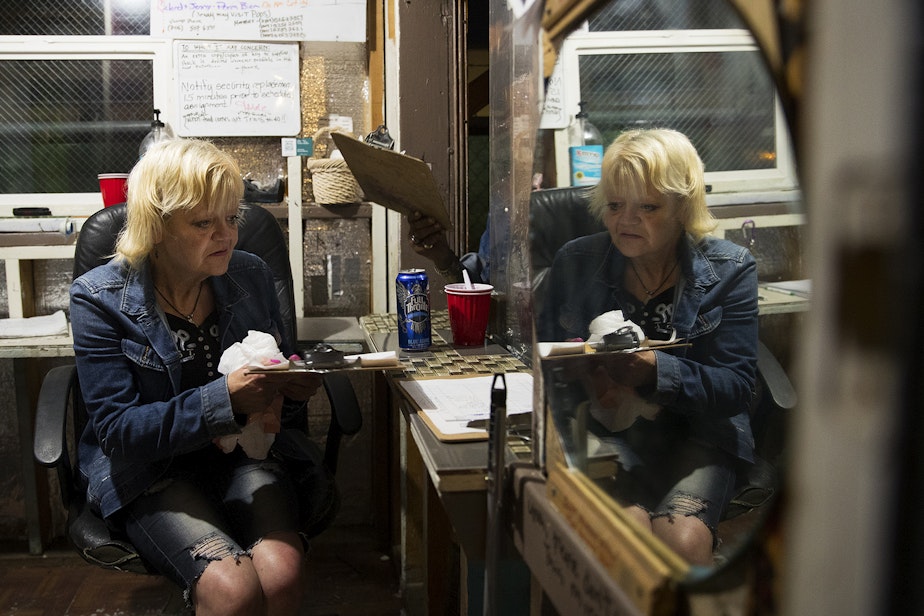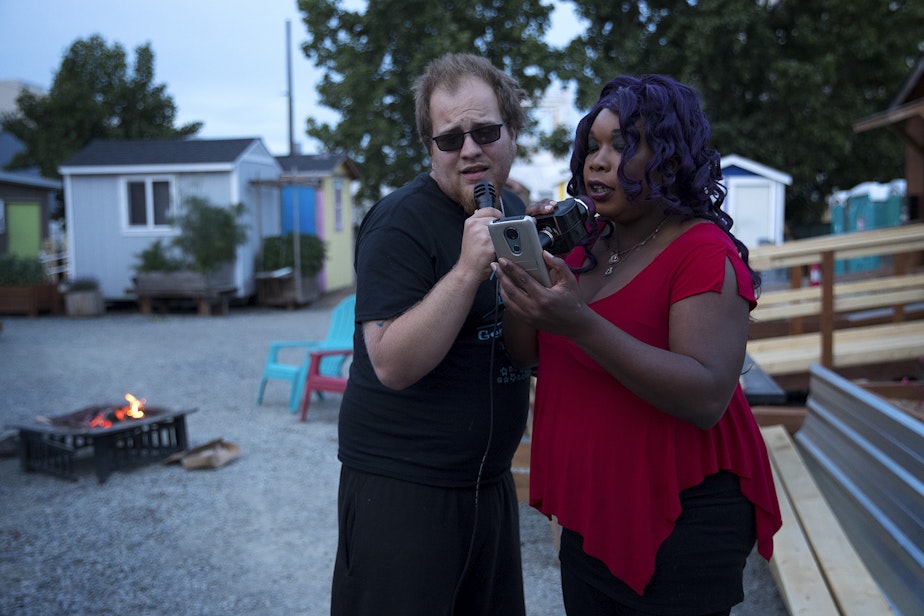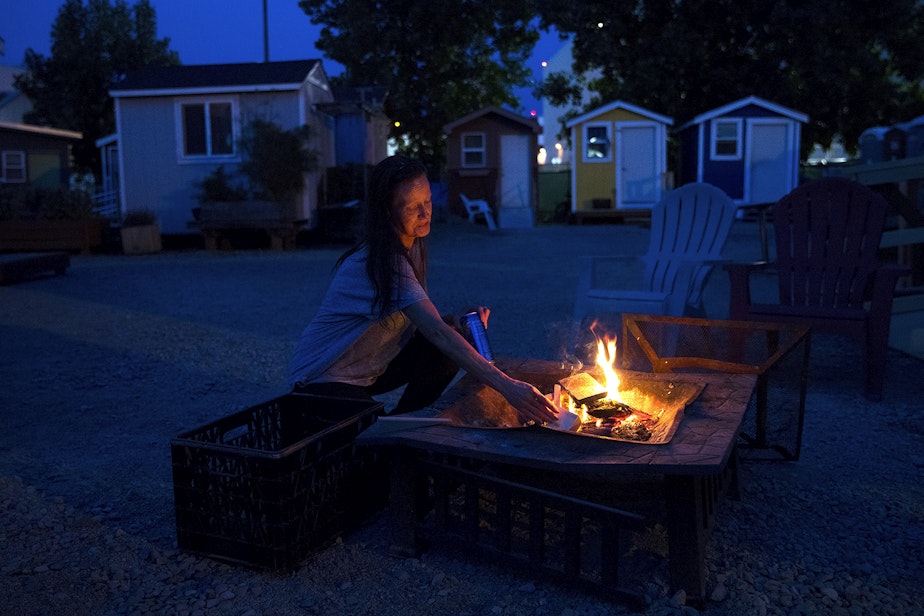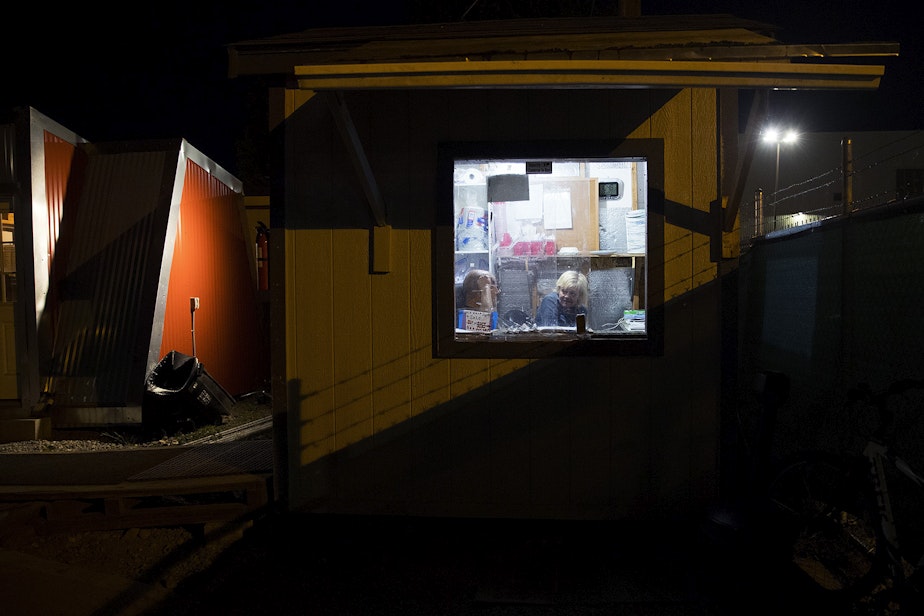‘One eye open.’ Sleepless in a Seattle tent

It’s 8:57 p.m. on a Sunday, and it’s karaoke night at the Georgetown tiny house village.
Residents sing along, pets mill about, and others gather at a fire pit.
And in three minutes, two residents named Teresa and Mike (they asked that we not use their last name) will take over guard duty at the security shack beside the front gate.
“I was just about ready to do some writing and then after that probably go and do a walk-through and see if everything is kosher out there in the camp,” Teresa said.
Shifts in the guard house run 24 hours a day.
Teresa and Mike are scheduled for 9 p.m. to midnight. Their job is to stay alert to all comings and goings.
Sponsored
This is one of eight city-permitted tiny house villages in Seattle for people who are homeless. The tiny houses live up to their names: At 8 feet by 12 feet, their footprint is a little smaller than a standard parking space.
But they’re considered a step up from a tent. They offer protection from the elements and a door that locks, and there are services on site.

“Our group is mainly people who have been living on the streets, sleeping rough in a greenway, under a bridge, in a doorway for five years, ten years, sometimes longer,” said Andrew Constantino, site manager at the village. He also lives there.
Sponsored
“This is the best living situation they’ve had in a very long time,” he said.
Tiny house villages are intended to be a stop on the way to something better, like permanent housing. The small, colorful structures sit in neat rows beside a larger communal structure which houses the kitchen, showers and laundry. There are port-a-potties near the front fence.
Before Teresa moved here, she lived in a tent for about a decade. She said when she arrived, she started to feel safe.
“It was such a big difference and a big relief,” Teresa said.
“I could actually sleep a whole entire night and not be scared and, you know, actually put some pajamas on or something. Out there you had to sleep with clothes on and one eye open.”
Sponsored

Before, when Teresa was outside, without a locking door or a fence and people on guard duty, she said she was in fight-or-flight mode at night.
“Being a woman by myself, I would listen to all the noises, and I would think someone is creeping around out there,” she said. “I would have to just have a lot of faith.”
Other residents at the tiny house village have similar stories about the challenges nighttime brought when they were living rough. For Stacy, it was spiders inside her tent during the spring. Or concern that her phone would die and her alarm wouldn't go off.
"If I had an appointment, I was afraid to go to sleep because I was afraid I wouldn't wake up in time and I'd miss it,” she said.
Sponsored
That sleep deprivation made it hard to function the next day. Sometimes, Stacy said, she would fall asleep on the bus.
For Andrea , who lived under a bridge with her husband before she came to the village, it was rats.
"My husband would have to sit up at night and make sure no rats got into our tent,” she said. “You know, so I could sleep at night."
Some researchers and people with lived experience of homelessness say meth can be seen as an option for people living on the streets because it helps keep them awake and vigilant at night.
Bobby Watts, head of the National Health Care for the Homeless Council, said sleep deprivation among the homeless is a silent epidemic.
Sponsored
"We know that it impairs your ability to make judgments,” he said. “It affects your mood, it weakens your immune system. It also makes you prone to certain chronic diseases."
Watts said inability to get good sleep can make it harder for people to function, which can make it harder to leave the streets.

Back in the tiny house village, midnight approached, the end of Teresa and Mike’s shift. A woman named Hattie arrived for the next three-hour stint in the guard house.
"Every shift has its own little chore going on,” she said. “Chores like, make sure that the Honey Buckets are stocked. Next person would make sure that the kitchen is pretty clean.”
Hattie said she doesn't mind doing a late shift on security. She said having someone on guard 24 hours a day is part of why she feels safe at the village.
"I feel so fortunate to be here,” she said. “Most people who are homeless in Seattle right now do not have this level of security, do not have this level of safety. And my heart breaks knowing that."
In the wee hours of that Monday morning, street lights blazed, but most of the lights in the tiny houses were out.
Hattie would be on duty two more hours — just another person working the night shift in Seattle.

